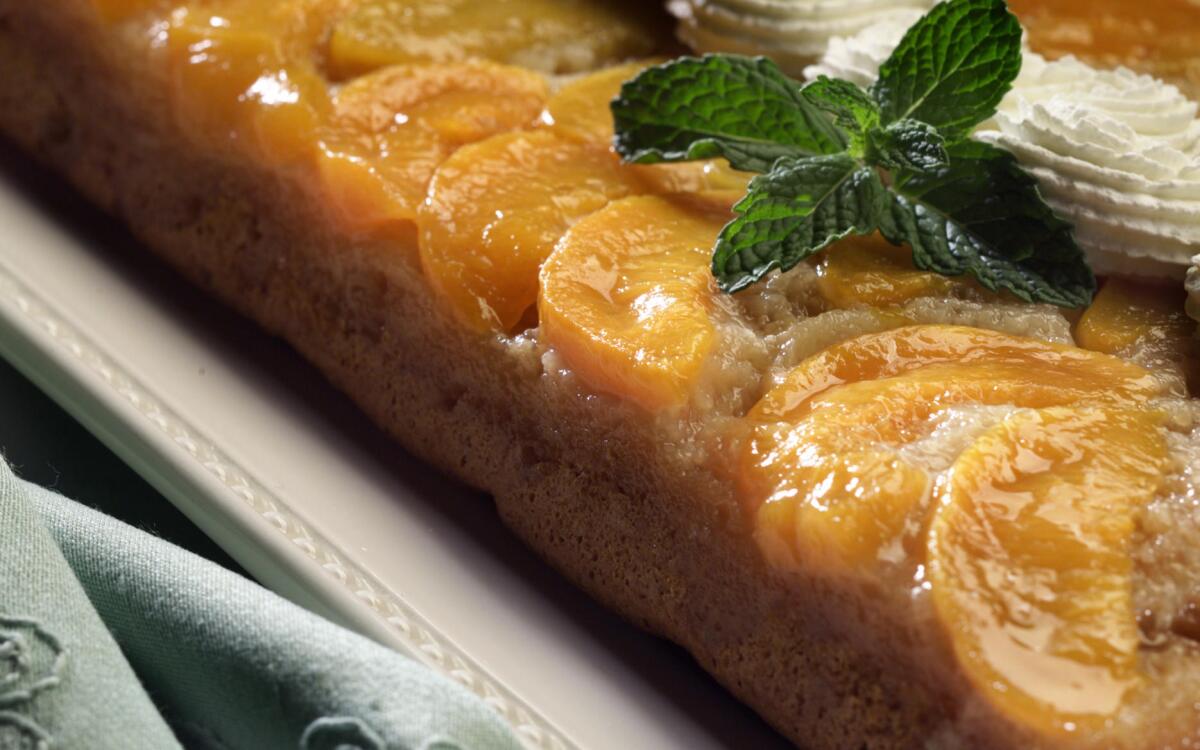Peach Upside-Down Cake

When you consider the fuel shortages of World War II, California’s present energy crisis doesn’t seem half bad. At the most basic level, our cooking and eating habits haven’t changed for want of electricity or gas. Even with the uncertainty of rolling blackouts, we can still zap quick meals in the microwave, roast chicken in the oven, stir-fry atop the stove. At least, so far.
Sixty years ago, however, home cooks had to adapt to restrictions placed on fuel consumption. In January 1943, the Los Angeles Times reported that the War Production Board had urged 18 million housewives to reduce their use of natural gas-a “vital” resource of America’s war effort. (Nationwide gasoline rationing began in 1942 and ended in 1945.) “Nine-tenths of all the food consumed by the average family is said to be cooked on top burners,” The Times said. “For the duration, that’s all wrong. We must brush up on our thrifty oven-meal technique.”
As food editor Marian Manners explained, “it saves gas to cook an ovenful of foods at one time instead of using all the top burners of the stove for getting dinner ready.”
Today her words seem folksy and quaint, but this was serious business: “Modern ovens have sturdy heat-saving insulation, which keeps all the heat where it does the most good, and dependable thermostatic controls that measure the exact amount of heat and gas required for the cooking job as thriftily as you measure precious ingredients for your cake recipe.”
To make meal-planning easier, Manners suggested several menus for oven-cooked dinners. For instance, “Menu No. 1” included rolled flank steak with walnut stuffing, steamed carrots, string beans with chili sauce and a peach upside-down cake. All were to be cooked at 325 degrees for 1 hour, the cake on the upper shelf, the other items on the lower shelf in tightly covered casseroles and saucepans. The cake would be removed 10 minutes before the rest of the meal.
“Menu No. 2” called for baked salmon, small steaks, steamed peas, scalloped potatoes and apple dumplings, with a green salad with avocado and French dressing served on the side. Manners advised cooking the entire lot at 425 degrees for 45 minutes.
By the 1940s, natural gas had long been fueling America’s kitchen stoves. Gas stoves were first mass-marketed in the late 19th century, and gradually eliminated less sophisticated wood-and coal-burning ovens.
In the first few years, however, families had doubts about the new contraptions. Not only did gas have to be bought, but homes had to be outfitted with connecting pipelines and ceiling flues for the venting of fumes. If the gas pressure dropped (as it did in those early days), the flame became too small to keep the food cooking. Or in cold weather, moisture froze in the lines and put out the flame altogether.
Improvements in the first half of the 20th century included the development of the oven regulator-a thermostat that would hold oven temperatures to a desired heat. Also, Corning Glass Works introduced Pyrex glass baking dishes-heat-resistant cookware that spread heat evenly, cleaned easily and could be carried to the table as serving dishes.
In her 1943 Times story, Marian Manners suggested staging a “dress rehearsal” for oven cookery by fitting empty pots, pans and plates into a cold oven. “For example,” she wrote, “select a shallow pan for meatloaf, a covered casserole for scalloped vegetables, a covered pan for steamed vegetables and a pie plate.” Her hard-and-fast rule was this: aluminum works best for steaming, glass for baking.
Naturally, Manners would prefer using a glass dish for her peach upside-down cake from “Menu No. 1.” The dessert, which calls for canned peaches and homemade whipped cream, makes for a wonderful winter treat. And since sugar rationing had also taken effect in 1942, the recipe incorporates honey as a substitute in the batter.
Peach cake
Heat the oven to 325 degrees.
Cook the juice from the peaches in a heavy pot over medium heat until thickened to heavy syrup, 10 to 12 minutes. Pour the syrup into the bottom of an 11x7-inch baking pan. Add the 1/4 cup honey. Dot with the butter and arrange a thick layer of peaches over the top.
Beat the eggs yolks until thick and lemon-colored, 4 to 6 minutes. Gradually add the 2/3 cup honey, beating constantly. Add the lemon juice and blend. Add the hot water and beat hard for 3 minutes.
Sift together the flour, baking powder and salt and stir into the egg mixture.
Beat the egg whites until stiff, 3 minutes, and fold into the mixture. Pour the batter over the peaches and smooth with an offset spatula. Bake the cake until it’s firm on top and golden brown and a toothpick inserted in the middle comes out clean, 30 to 35 minutes. Cut it into pieces and serve with whipped cream.
Whipped cream
Beat the cream, sugar and vanilla together until firm, 3 to 5 minutes.
Get our Cooking newsletter.
Your roundup of inspiring recipes and kitchen tricks.
You may occasionally receive promotional content from the Los Angeles Times.















